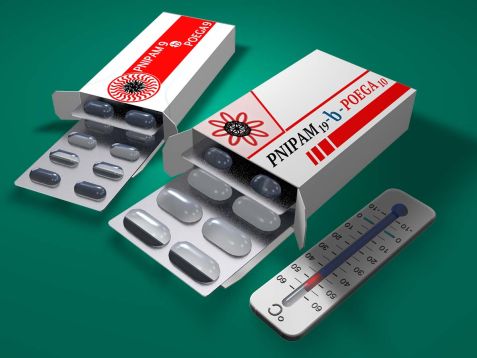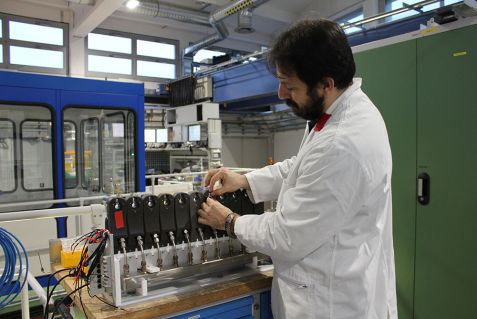MLZ is a cooperation between:
 > Technische Universität München
> Technische Universität München > Helmholtz-Zentrum Hereon
> Helmholtz-Zentrum Hereon
 > Forschungszentrum Jülich
> Forschungszentrum Jülich
MLZ is a member of:
 > LENS
> LENS > ERF-AISBL
> ERF-AISBL
MLZ on social media:

MLZ (eng)
Lichtenbergstr.1
85748 Garching
26.04.2022
Smartly solved: How molecules release active ingredients in a targeted way

Double hydrophilic PNIPAM-b-POEGA block copolymers are already successfully used in the encapsulation of anti-inflammatory drugs in pharmaceutical applications. A precise understanding of the temperature- and composition-dependent structural changes is therefore very important for their further development in the direction of targeted release of active drug ingredients. © Reiner Müller, FRM II / TUM
Smart molecules can change their shape and properties depending on temperature or other parameters such as macromolecular architecture. In pharmaceutic applications, they release active ingredients in a targeted manner at the desired locations. Neutrons at the MLZ reveal these nanostructures and help specifically design new molecules with desired properties.
The smart part of the molecules studied here is based on the different water solubility of the components in a solution, as every hobby cook knows: water and oil do not mix, for instance. On the contrary, the molecules arrange themselves in such a way that they form clearly defined oil droplets, which float on the water surface. The concept of the hydrophilicity difference, i.e., differences in water solubility, also ensures that the so-called double hydrophilic block copolymers can take on far more complex forms at the molecular level in aqueous solutions. This is because they have both water-soluble (hydrophilic) and water-insoluble (hydrophobic) components. The form they take depends on the relative proportion and the exact molecular chemistry of the two components.
Less solubility at increased temperature

Dr. Apostolos Vagias prepares the samples for measurement in the temperature-regulated sample container of the SANS-1 instrument. © Georgios Mantzaridis, FRM II / TUM
But how can the shape of the self-assemblies of such macromolecules be controlled? For this purpose, macromolecular components are used that change their water solubility depending on the temperature, for example. A group of German and Greek scientists has investigated nanoscale structures in water from a diblock copolymer molecule, known as PNIPAM-b-POEGA. It belongs to the group of double hydrophilic block copolymers and consists of two polymer blocks POEGA (poly(oligoethylene glycol methyl ether acrylate)) and PNIPAM (poly(N-isopropylacrylamide)) which are covalently bound along the polymer chain. Both are hydrophilic, but PNIPAM becomes more hydrophobic in water with increasing temperature. The comb shaped POEGA variant on the other hand has been synthesized with hydrophobic end groups at its end. The structural influence of their interplay between groups of different affinity to water is difficult to predict and thus particularly interesting to measure. Polymers consisting of both such blocks respond to a change in temperature by rearranging themselves in space and changing the structure of the self-assemblies, which are formed. Thereby they can release the active ingredient of a drug, as has been already successfully implemented.
The exact mechanism of the shape change in these polymeric nanostructures with increasing temperature and the accompanied distribution of water molecules has not yet been thoroughly researched. This was the aim of the measurements made by Dr. Apostolos Vagias, instrument scientist at the SANS-1 instrument at MLZ, together with his colleagues from the Technical University of Munich, the Heinz Maier-Leibnitz Zentrum, and the National Hellenic Research Foundation in Athens. “These are the first structural studies with comb-shaped polymers like POEGA, which lead to a more complex architecture of the self-assembly also due to the hydrophobic end groups present next to the purely hydrophilic POEGA block,” explains Dr. Vagias.
Targeted development of more efficient active ingredients for pharmaceuticals
Dr. Vagias investigated two variants of the PNIPAM-b-POEGA block copolymer: a symmetric version in which both blocks are of equal length and an asymmetric version in which the PNIPAM block is twice as long as the POEGA block. With the combined measurements using small-angle neutron scattering at SANS-1 and infrared spectroscopy at TUM, he found noticeable structural differences between the two versions at different length scales: The results and the modelling of the neutron measurement show that in the asymmetric version, the POEGA blocks fold back towards the PNIPAM core at high temperatures, while in the symmetric version they stretch outwards like spikes. These changes in the nanostructure go hand in hand with changes in the concentration of the solvent, in this case water, at the side chain groups of the molecules. With the help of infrared spectroscopy, he could identify these changes on the molecular scale.
The results were received with a positive response from experts in this field, and his publication is featured on the cover of the ACS journal “Macromolecules” for August 10th, 2021. “Now we know how the temperature and the composition influence the self-assemblies of the molecules over a broad range of length scales. This helps us to understand how to develop precision pharmaceuticals that can for example release the active component in a temperature- controlled way”, says Dr. Vagias.
Original publication:
Effects of Polymer Block Length Asymmetry and Temperature on the Nanoscale Morphology of Thermoresponsive Double Hydrophilic Block Copolymers in Aqueous Solutions. Apostolos Vagias, Aristeidis Papagiannopoulos, Lucas P. Kreuzer, Despoina Giaouzi, Sebastian Busch, Stergios Pispas, Peter Müller-Buschbaum. Macromolecules 54 (15), 7298 (2021)
DOI: 10.1021/acs.macromol.1c01005
More information:
Scientists from the Technical University of Munich (TUM) and Helmholtz-Zentrum Hereon at the Heinz Maier-Leibnitz Zentrum, the Chair for Functional Materials at the Physics Department of TUM and the National Hellenic Research Foundation in Athens were involved in the measurements.
National Hellenic Research Foundation
https://www.eie.gr/index-en.html
Chair for Functional Materials
https://www.ph.nat.tum.de/en/functmat/about-us/
MLZ is a cooperation between:
 > Technische Universität München
> Technische Universität München > Helmholtz-Zentrum Hereon
> Helmholtz-Zentrum Hereon
 > Forschungszentrum Jülich
> Forschungszentrum Jülich
MLZ is a member of:
 > LENS
> LENS > ERF-AISBL
> ERF-AISBL
MLZ on social media:


